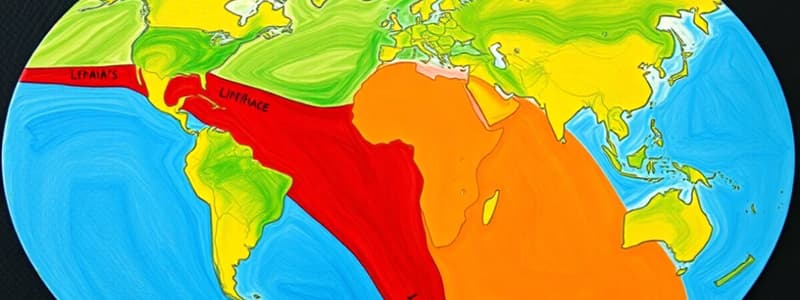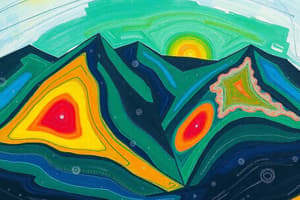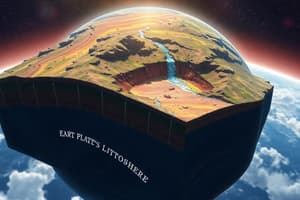Podcast
Questions and Answers
Which geological activity is least likely to occur at a transform plate boundary?
Which geological activity is least likely to occur at a transform plate boundary?
- Volcanic activity (correct)
- Earthquakes
- Seismic activity.
- Lithospheric deformation
At a divergent plate boundary, what geological process is primarily responsible for the creation of new lithosphere?
At a divergent plate boundary, what geological process is primarily responsible for the creation of new lithosphere?
- Upwelling of magma from the mantle (correct)
- Uplift due to continental collision
- Compression and folding of continental crust
- Subduction of oceanic crust
In an oceanic-continental convergent boundary, which plate subducts and why?
In an oceanic-continental convergent boundary, which plate subducts and why?
- The continental plate subducts because it is thicker.
- The oceanic plate subducts because it is denser. (correct)
- Neither plate subducts; they form a transform boundary.
- The continental plate subducts because it is denser.
What is the primary process responsible for the formation of tall mountain ranges at continental-continental convergent boundaries?
What is the primary process responsible for the formation of tall mountain ranges at continental-continental convergent boundaries?
Which of the following mechanisms is considered the dominant force driving the movement of lithospheric plates?
Which of the following mechanisms is considered the dominant force driving the movement of lithospheric plates?
At which type of plate boundary is ridge push most commonly observed?
At which type of plate boundary is ridge push most commonly observed?
Which process explains the presence of marine fossils at the summit of Mount Everest?
Which process explains the presence of marine fossils at the summit of Mount Everest?
Iceland is an exception to most divergent boundaries because it:
Iceland is an exception to most divergent boundaries because it:
Which plate boundary is characterized by plates neither creating nor destroying lithosphere as they slide past each other?
Which plate boundary is characterized by plates neither creating nor destroying lithosphere as they slide past each other?
How do radioactive elements contribute to plate movement?
How do radioactive elements contribute to plate movement?
Flashcards
Plate Boundary (Divergent)
Plate Boundary (Divergent)
Area where two tectonic plates separate or diverge from each other.
Lithospheric Plates
Lithospheric Plates
Also known as tectonic plates; can vary in sizes and are constantly formed, deformed and destroyed.
Divergent Boundary
Divergent Boundary
Boundary where plates move apart, creating new lithosphere. Associated with volcanism and some seismic activity.
Convergent Boundary
Convergent Boundary
Signup and view all the flashcards
Transform Boundary
Transform Boundary
Signup and view all the flashcards
Subduction
Subduction
Signup and view all the flashcards
Orogenic Activity
Orogenic Activity
Signup and view all the flashcards
Suture Zone
Suture Zone
Signup and view all the flashcards
Convection Current
Convection Current
Signup and view all the flashcards
Ridge Push
Ridge Push
Signup and view all the flashcards
Study Notes
Plate Boundaries
- These are the areas between where two plates have separated or diverged from one another.
Lithospheric Plates
- Also known as tectonic plates
- Can be large or small in size
- Formed, deformed, and destroyed over roughly 400,000 years (Wilson Cycle).
- Important examples include the Pacific, North American, and Eurasian plates.
- Most dynamic geological activity occurs at plate boundaries
- Examples include volcanic and seismic (earthquake) activity.
Types of Plate Boundaries
- Divergent/Constructive: Plates move apart.
- Convergent/Destructive: Plates come together.
- Transform/Conservative: Plates slide past one another.
Transform Boundaries
- Plates slide past each other
- Lithosphere is neither lost nor added
- Earthquakes are common, but volcanic activity is not
- Famous examples include the San Andreas Fault and the Alpine Fault.
Divergent Boundaries
- Plates move apart
- New lithosphere is created (constructive)
- Site of some of the youngest rocks on Earth
- Magma rises to fill the gap as plates separate
- Associated with volcanism (eruptions, hot springs) and some seismic activity
- Typically submarine, with exceptions like Iceland
- Example: South America moving away from Africa.
Convergent Boundaries
- Plates come together, resulting in crust consumption.
- Three types: oceanic-continental, oceanic-oceanic, and continental-continental.
Oceanic-Continental Convergence
- The denser oceanic plate subducts beneath the continental plate at a subduction zone.
- Creates orogenic activity (mountain building)
- Results in earthquakes and volcanoes
Oceanic-Oceanic Convergence
- One oceanic plate subducts beneath another, based on temperature (denser, cooler plate sinks).
- Forms a subduction zone
- Can result in earthquakes and volcanoes
Continental-Continental Convergence
- Plates of relatively equal densities collide and squeeze upwards.
- Compression leads to tall mountains and seismic activity
- The area where they meet is called the suture zone
- Example: Himalayas
- Fossil evidence at the top of Mt. Everest
Plate Movement Mechanisms
- Three mechanisms contribute to plate movement: convection current, ridge push, and slab pull.
Convection Current
- Warmer rock/magma rises, cools, and sinks, dragging the lithosphere along.
- Heat source: radioactive element decay.
Ridge Push
- Gravity causes elevated lithosphere at the ridge axis to push lithosphere further away from the axis.
- Occurs at divergent boundaries, such as mid-ocean ridges
- Operates due to gravity.
Slab Pull
- Occurs at convergent boundaries (oceanic subduction zones).
- Older, colder, and therefore denser plates sink, pulling the rest of the plate downwards.
- Operates due to gravity.
- This appears to be the more dominant force in plate movement out of the two (ridge push and slab pull).
Studying That Suits You
Use AI to generate personalized quizzes and flashcards to suit your learning preferences.
Description
Explore plate boundaries: divergent, convergent, and transform. Learn about lithospheric plates, their formation, and the geological activities at their boundaries such as earthquakes and volcanoes. Examples include the San Andreas and Alpine Faults.




